Real-World Car Seat Installation Tips
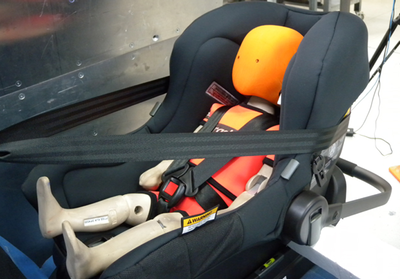
Driving around in cars is freaking dangerous. It just is. I’ve lost my fair share of friends and classmates in car accidents, so I’m probably a little more paranoid than the average bear.
On the topic of kids in cars? I’m a bit of a nervous Nelly, especially when it comes to other people driving my kid(s) around [shivers]. I’m sure this is something I will have to get over as they get older.
I decided to become a certified CPST (child passenger safety technician) so I could speak more competently about car seat safety.
Essentially, what I learned is… it’s not surprising that most car seats are installed incorrectly; it’s confusing stuff! There are just so many variables. Confession: The majority of the students in this class? Most of us had our car seats in wrong too… or we had screwed up some other critical aspect of the installation.
Oopsie doops. Tee hee.
On the last day of the class, we did a public car seat check at the local Walmart and believe-you-me, sister, we saw some f’d up s#it (yes, I felt it necessary to use two 4-letter words there). We saw a baby in the front seat, we saw 2-year-olds in boosters, we saw some really old, expired seats à la 1985. You name it.
There are some really interesting and useful tidbits that I want to share with every parent who has a kid in a car seat in hopes of clearing up some of the major misconceptions and points of confusion. Here goes…
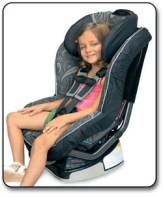
The 5-pt Harness is your Friend
Most people put their child into a seatbelt (and out of the 5-pt harness) WAY too early.
That said, most kids are mature enough by the age of 5 or 6 to graduate to a booster/seatbelt, thus you may want a higher weight limit harnesses seat to get you to that age (you know your child’s heft the best). Read also: what’s the right age for a booster seat?
Onward.
Positioning
Rear-facing seats are soooooooooooo much safer than forward-facing seats. Generally speaking… children have fragile, flexible neck muscles. When a forward-facing child’s heavy head is thrust forward in a crash, the child suffers an enormous amount of stress on the neck. If the spinal cord stretches too far in a crash (a mere 6 mm), the child may suffer paralysis or death.
In the real world, I’ve noticed that most parents turn(ed) their kid around shortly after his/her 1st birthday. Trust me, I understand the desire to hand food or a sippy cup back to your kid in order to quiet her down, but watch this video and you’ll understand the huge difference in the crash dynamics of the two positions (cue to 1:35). In fact, a child is 75% more likely to sustain a serious injury if he is forward-facing.
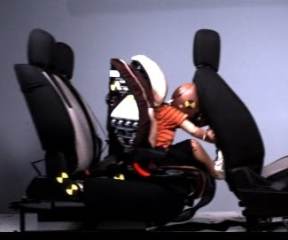
Essentially, a seat that is rear-facing inherently cradles a child’s brain and neck. Try to wait until your young’un is at least 2-years-old before turning them around — or even longer if you can stand it!
“As a medical community, we are really, really good at fixing bones; we can fix almost any broken bone in your body. We are very bad, however, at fixing broken spinal cords and swollen brains.”
– Gina, CPST instructor and ER nurse
Side-Impact
Frontal collisions are by far the most common type of collision, but side-impact collisions are the most deadly (people running red lights, stop signs, etc.). The good news is that many (most?) newer cars now have side and/or “curtain” air bags (and since 2013, they all should have them).
The bad news is that – currently — there are no standards for side-impact protection for car seats in America (Europe? Yes, here? No), but MANY car seat manufacturers have taken this upon themselves. In my opinion, side-impact protection is what separates a good seat from a great seat. Yes, you’ll probably pay more, but it’s worth it.
Skip to: Best Convertible Car Seats
Front Seat
You can, if absolutely necessary, put a FORWARD-FACING child seat in the front seat if it’s the last resort (with the seat pushed back as far as possible). A rear-facing car seat, however, should NEVER go in the front seat unless you’re absolutely sure you can disable the air bags. Why? Here’s the scenario: You get into a minor fender-bender and suddenly, your frontal air bags get deployed at 200 mph. The rear-facing baby then gets catapulted into the seat and is instantly killed. If you don’t believe me, I’ll tell you some terrible stories from the ER nurses at my CPST training class. Really sad stuff.

Rear-facing in the front seat: no
Using LATCH in the middle seat
All things being equal, the back seat, center position is the safest place to install a car seat. However, vehicles are only required by law to have two LATCH positions — and in 70% of vehicles, these two positions are in the “outboard” or side seats (i.e., not in the middle). You will often only find center LATCH connectors in large, wide cars and trucks. Given the choice, I’d rather do a seat belt installation in the center even if it’s a little more tedious than using LATCH.
— As a follow-up, if your car doesn’t have LATCH hooks in the middle seat (and most don’t), you should not use the “inner” right and left LATCH hooks (i.e., the ones intended for the outboard seats) to install a seat in the middle (make sense?). There are vehicles where you CAN do this, but only if both the car maker AND the car seat manufacturer okay it. Read more here: ** This is a very common mistake that parents make.
Seat Belt Shenanigans
ELR vs. ALR seat belts, whaaaat?
A bunch of confusing acronyms do exactly that: they confuse people. Most people are confused about when to use the locking clip (the “H” shaped clip that comes with your seat).
If your car was made after 1996, you probably do NOT need to use a locking clip. Long story short, cars after 1996 are required to have back seat seat belts that have two modes: ELR mode (let’s call this “adult comfort” mode, you can move around freely, etc.) and ALR mode (let’s call this “car seat installation” or “locked” mode). Thus, most lap-shoulder belt systems have “switchable” retractors, which means if you pull the belt allllll the way out, then let it slowly feed back in, you have switched it from “adult” mode to “child seat” mode, and thus, you do not need to use the locking clip because you are “pre-crash” locking it. Dig? (Just nod.)
However, EACH time you install the seat with the seat belt, you MUST switch the belt into ALR mode (a.k.a. child seat mode) by pulling the belt all the way out and letting it retract snugly in order to engage the locking mechanism. It’s easy to forget! That’s another big mistake that people make.
FAQ: “Which is safer: LATCH or the seat belt?” There truly is no difference. They are equally safe. If LATCH is easier for you to use correctly, use it. If the seat belt is easier for you, use that. Point: Use the one you have less of a chance of screwing up. P.S. Don’t use them both at the same time.
LATCH
The LATCH hooks in your car are typically only rated up to 40-45 lbs (remember I talked about those seats that go up to 80 lbs?). Most people don’t know this and have 45+ lb children in car seats that are installed using LATCH. This is a major no-no (and again, how would anybody ever know this? It’s not exactly common knowledge).
Check your owner’s manual for your car’s LATCH weight limit and – yes — you’ll have to go back to using the good old-fashioned seat belt until auto makers can catch up with car seat trends and make their LATCH hooks hold more weight.
- Update: All car seats manufactured after February 2014 will have a label that clearly defines the maximum weight limit for installing that car seat with lower anchors. That maximum weight limit will equal 65 lbs when the car seat weight and the child’s weight are combined.
Top Tether
In the forward-facing position, the top tether (or as I think of it, the “rear” tether) is really, really important, yet most people don’t use it. This top tether secures the back of the seat, thereby reducing “head excursion,” which is how far the head and neck travel forward in a collision (see below).
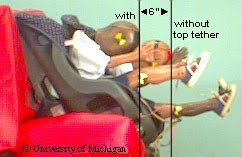
If your car was made after Sept 2002, your car has LATCH (and thus, rear tether hooks), you just need to find ’em. In some cars, they are on the back of the seat, some are in the ceiling, some are on the floor behind the seat; check your owner’s manual for the location if you can’t find them. In fact, even if you are installing the seat with a seat belt, you can (and should) ALSO use the rear tether to secure the seat.
Harness Straps
Last but not least, my biggest peeve of all: your harness straps are not tight enough, parents! 90% of you are guilty of this. You shouldn’t be able to “pinch” any slack in your harness straps.
A friend said to me the other day, “Ally is always pulling her arm out of her car seat.” OMG woman, if your kid can pull her arm out of her car seat straps, it’s waaaay too loose. Come on now! As my dad would say, “get with the program!”.
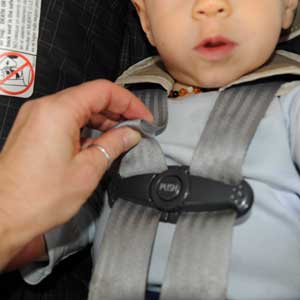
Every seat has a button that allows you to release the straps and pull them loose, typically between the legs. You then tighten the straps again by pulling the big cord between the legs. Learn how to use it (seriously).
That’s all for now. Please check out our favorite infant and convertible seats.
Peace,
Meg Collins, CPST<— yeeaaaah, baby — who needs an MBA when you can be a CPST?? (sarcasm)
Related:
- The Lucie’s List 0-40 week + postpartum newsletter archives
- The Umbrella Stroller Buyer’s Guide
- Connect with us on Facebook
Meg, Can you please give me some recommendations for a car seat for a tall kid? My sister’s 6 month old is outgrowing her infant car seat and is very tall for her age. I’m looking to buy a convertible seat that will last her as long as possible. Thanks!
Jane, I would look at Safety 1st Complete Air, the Cleck Foonf, the Diono Radian, Chicco NextFit and Graco Size5Me — these are among the tallest shells on the market. Cheers!
Hi Meg,
Any recommendations on a harness to booster seat (ex. Britax Frontier)? My soon-to-be three year old is 39 inches and in a convertible seat now — I don’t want to give up the harness yet, but he is rapidly outgrowing the convertible seat. Any help would be much appreciated!
Thanks!
why yes! please see https://www.lucieslist.com/guides/best-car-seats-for-toddlers-and-preschoolers/forward-facing-car-seats/
Talk about a mommy fail! I just realized that we have been doing what you said not to do for over a year! Our infant seat, which we are about to replace with a convertible seat, is secured in the middle with the out board latches! It does not move at all, but I had no idea it was wrong. How disappointing!!!
Is it okay to have a seat cover on the seat as a barrier under the infant car seat? It’s to protect the leather seats from the dog’s nails but I can take it off it’s not safe. It’s securely latched to the seat and the infant car seat does not move once installed. Thanks!
Hi Kimberly! It’s hard to say if your seat cover would be ok if under your car seat. Car seat manufacturers would tell you “no” because they haven’t tested it, etc. However, if you have the car seat properly installed and tightened, you’re probably ok. But just to be certain and safe, we recommend that you take your installed protector and car seat to an inspection location. See all locations here: https://www.safercar.gov/cpsApp/cps/index.htm
HI!
May be a silly question but wanted to double check.
My son just turned a year. We plan to keep him rear facing at LEAST until 2. I was thinking we would still need to get him into a convertible seat but looking at this, I”m not sure it’s time. Right now we have the Britax B-safe, which has a weight limit of 30lbs. Babe is currently 20lbs. His feet hang over a bit but overall he’s still fitting in there.
Question is, how do we know when it’s time to switch over? (besides weight).
Thank you!
You can keep him in there until a. he gets too tall b. he starts protesting because he’s no longer comfortable. Otherwise, you are free to keep using your infant seat 🙂 If he just turned a year, it shouldn’t be much longer until you upgrade.
Hi Meg,
Super helpful article, thank you! Question for you – is there a safer side of the vehicle to put your car seat? A friend recently told me you must put them behind the driver because it’s the “safer side”, but I haven’t really seen that in any of the research I’ve done.
Thanks!
Hi Sarah! Great question! Whenever possible, it is ALWAYS recommended to place the car seat in the center. However, if that is not possible, there is no “safer” side (driver or passenger) of the back seat – choose whichever works best for you. Check out this article for more information.
Hi Meg – Quick question for you. We are expecting twin girls shortly and also have a two year old. We are trying to determine if the car seat configuration we have is safe. Our car only has 2 latch positions, as you described, so we have the center car seat installed with the seat belt and the side ones using the latches. For configuration, the best way to make it fit is to put one of the infant car seats in the middle, one on the side and our daughter’s forward facing seat on the other side. Does this configuration sound safe? It’s a tight squeeze but all the car seats are correctly installed. We took it to the fire department and they really wanted to see the toddler seat in the middle seat but if we do this, it really doesn’t fit as well. I also can’t figure out why this was critical to them. Also, if we keep the toddler seat on one of the side seats, do you recommend one over the other (i.e. passenger or driver side?) Let me know your thoughts. Thank you! Eliza
Hi Eliza — sounds perfectly fine to me, and sorry for the late reply. 3-across is hard, so any way you can get it to work is WINNING! Just ensure the seats are installed straight and not off at an angle (what commonly happens when there isn’t enough space). I have no preference on which side to place the toddler seat, esp if it’s rear facing as well. Sounds like you’re good to go 🙂
Hi Meg,
Do you know which convertible seats are best for an infant (10 months) with hip dysplasia but not in a cast or brace in the car seat? My son has mild hip dysplasia and wears a brace at night but I want to get the seat with the most space for his hips to be froggied out..
Thanks!
Tanya
Tanya, I don’t think that any one convertible car seat would have *enough* more room than any other one to really register a difference. Instead, I would recommend a specialty seat made by Maxi Cosi called the Opal: https://www.maxi-cosi.com/service/hip-safety-service/opal-hd.asp Hope this helps!!
In your article you advise not to ever use both the LATCH and seat belt to secure the seat at the same time. Could you please explain why, I would think that gives extra protection.
Hi Judith! Go down to “Analogy” in this article here. Hope this helps!
Hi Melissa,
I use the Sit n Stroll by Lily Gold when traveling with my one year old. It is difficult to install rear facing and get the correct angle of recline. The manual and other references recommend using a rolled towel or pool noodle. I have not been able to find detailed instructions or videos on how to install this seat with a pool noodle or towel. Do you have any tips or references? And is using a pool noodle safe?? Would it be better to use it forward facing? Thank you.
Hi Raneshia- Meg here — I can help. This is a common problem with travel seats. You can use anything that will prop your car seat up; I’ve even used a coat in a jam. Please see here: https://csftl.org/use-a-pool-noodle-to-adjust-the-recline-of-a-rear-facing-car-seat-how-to/
You can use anything as long as its tightly rolled and not highly compressible (I doubt you’ll want to travel with 3 pool noodles, right?) Hope this helps! Meg
Hi Meg,
City girl here and will get to driving very soon, but don’t do it yet and I imagine I will need some practice to get really comfortable. Currently, when I’m with my 13mo old daughter and need to get someplace, we walk or I have her in a carrier and we take the bus.
When we need to go by car (meaning taxi), I have her in the infant car seat, and bring the stroller which the seat easily attaches to and off we go. Soon, we will be moving onto the convertible car seat and then what?! If I need to take her to an appointment or whatever it may be, is it a matter of installing the convertible seat in the cab (Lyft) and carrying it to and fro? I need to get driving…
This is the most challenging time period to be in the city (the convertible seat). The best advice I have is the Chicco Fit2 with a compatible stroller. Unfortunately, there is no better solution; many New Yorkers will tell you they don’t use a car seat, which IMO is terrible idea.
hi there!
If my car has latch anchors but only on the outbound seats, is there a safer place to put the seat (backseat passenger or driver’s side)? Also – can I install using the seat belt if there isn’t latch connectors in the middle?
Thanks!
Beth
Hi Beth! The safest place for a car seat is in the middle of the back seat. And, yes, you can install using the seat belt – just be sure to check your car seat manual and vehicle manual to confirm. If middle seat is not an option, either outbound seat is fine. However, I prefer the passenger because it’s safer for loading/unloading when parallel parking.
Hi there!
If the Graco 4Ever $ in 1 Car Seat goes up to 120 lbs. Why would it never live up to it expectation to last the lifetime of needing a car seat for a child like you said it wouldn’t?
Hi Temi! Unless your child has special circumstances, the Graco 4Ever 4-in-1 will most likely last through the lifetime of needing a car seat. Hope this helps!
Hi there! Awesome post. Could you comment on the safest locations for two car seats? My daughter is 4 (forward facing) and my son is 1 (rear facing). Thank you!
Hi Brittany! The middle is usually the safest, but if a car seat doesn’t fit right because of a second seat next to it, then it’s best to have both car seats in the outside positions.